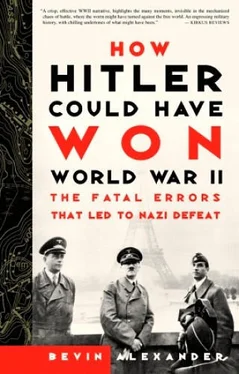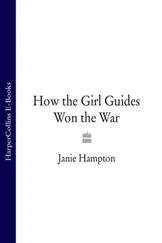p. 42: “role in deciding the war.” Shirer, 775–82; Dahms, 211; Zabecki, vol. 2 (Robert G. Waite), 1405–9; Liddell Hart, History of the Second World War, 87–108.
p. 43: “to British Guiana (Guyana).” Hitler made a great strategic error when he signed the Tripartite Pact between Germany, Italy, and Japan on September 27, 1940. The alliance was aimed at maintaining American neutrality by raising the prospect of a two-front war, against Germany and Italy in Europe and against Japan in the Pacific. This threat increased the determination of American leaders to arm the nation. But the pact encouraged Japan to risk an attack on the United States in the belief that in a two-front war Americans would be unable to defeat the Japanese navy, leaving control of the Pacific to Japan. This decision probably cost Germany and Japan the war. By seeming to offer Japan the opportunity to exclude the United States from the western Pacific, the pact encouraged Japan to seize the colonies of Britain, France, and the Netherlands in Southeast Asia (the so-called southern strategy). This diverted Japanese attention from its designs on Siberia, and led to a neutrality treaty with the Soviet Union in April 1941.
p. 44: “American entry into the war.” Paul Kennedy points out that the economic power of the United States dwarfed that of every other nation. In 1938, with at least half of its capacity idle because of economic depression, the United States still produced almost 29 percent of the world’s manufactured goods, more than twice that of Germany, whose factories were operating at maximum capacity. In 1937 the United States had three times the income of the entire British Empire, almost seven times that of France, four times that of Germany, and sixteen times that of Japan. In 1937, the United States possessed 41.7 percent of the entire world’s war-production potential. Germany’s share was 14.4 percent, the Soviet Union’s 14, Britain’s 10.2, France’s 4.2, Japan’s 3.5, and Italy’s 2.5. See Kennedy, 325–33.
p. 44: “a peaceful solution.” Kimball, 69–76; Zabecki, vol. 1, 108–9 (Paul G. Pierpaoli, Jr.).
Chapter 5: The Fatal Turn to the East
p. 45: “‘the spring of 1941.’” Hitler’s meeting occurred at Berchtesgaden in his Berghof (retreat) at Obersalzberg in the Bavarian Alps. All the top leaders of the armed forces were there.
p. 45: “invaded Russia in 1812.” Liddell Hart, Strategy, 236.
p. 48: “against the Soviet Union.” Das Deutsche Reich und der Zweite Weltkrieg, vol. 3, 191–200; Shirer, 813–15.
p. 49: “if the United States entered.” Shirer, 829; Kimball, 84.
p. 49: “never counsel Hitler correctly.” Das Deutsche Reich und der Zweite Weltkrieg, vol. 3, 197.
p. 49: “than capture of London.” Fuller, vol. 3, 413.
p. 53: “a single panzer division for Africa.” Alexander, 237. Soviet Foreign Minister V. M. Molotov went to Berlin on November 12, 1940, to discuss a four-power entente and “delimitation of spheres of influence.” Joachim von Ribbentrop, German foreign minister, outlined a remarkable proposal for Germany, Italy, Japan, and the Soviet Union to divide up Eurasia and Africa. But the plan had an air of unreality about it. Hitler had devoted large portions of Mein Kampf to describing his hatred of Communists and his desire to eradicate them. It is doubtful whether Joseph Stalin believed Hitler was serious. On November 26, he demanded a base in Bulgaria to secure control of the Dardanelles. This would place Romania under Soviet threat, and Romania’s Ploesti oil fields were a matter of life or death for Germany. Hitler abandoned the idea of a four-power alliance, and reached his final decision to attack the Soviet Union.
p. 55: “forced to cede to others.” Close to midnight on November 11, 1940, thirty obsolete Swordfish torpedo bomber biplanes from the British aircraft carrier Illustrious sank one and heavily damaged two Italian battleships lying at anchor at Taranto. The British lost two aircraft, and eliminated Italy as a naval competitor in the Mediterranean. The air strikes proved that bombers could sink capital ships. The Japanese learned the lesson, and were the first to realize that thereafter aircraft carriers were to dominate naval warfare. See Zabecki, vol. 2, 1708–9 (Francesco Fatutta).
p. 56: “for a hasty departure.” Beginning January 19, 1941, small British forces struck from Sudan in the north and Kenya in the south to evict the Italians from their East African colonies of Ethiopia, Eritrea, and Italian Somaliland, and from British Somaliland, which they had occupied in 1940. The British were aided by Ethiopians who accompanied Emperor Haile Selassie, exiled by the Italians when they conquered Ethiopia in 1935–1936. The Italians had 160,000 native and 100,000 Italian troops, but they retreated before the much smaller British forces. By April 6, 1941, the British had occupied Addis Ababa, the Ethiopian capital, and most other important places in the colonies. The last Italian force surrendered at Gondar, Ethiopia, on November 27. The campaign demonstrated poor leadership by Italian officers and a tendency of Italian soldiers to surrender or run away.
p. 57: “680,000 troops in Romania.” Romanian King Carol II was forced to abdicate in favor of his eighteen-year-old son Michael I, but General Ion Antonescu took control of the country and joined the Axis on November 27, 1940.
p. 59: “Yugoslavia from all quarters.” Das Deutsche Reich und der Zweite Weltkrieg, vol. 3 (by Detlef Vogel), 417–84; Liddell Hart, History of the Second World War, 131–35.
Chapter 6: Attacking the Wrong Island
p. 62: “‘in the Mediterranean.’” Das Deutsche Reich und der Zweite Weltkrieg, vol. 3, 487.
p. 63: “‘toward the Suez Canal.’” Ibid., 488.
p. 65: “actually in British lines.” Liddell Hart, The Other Side of the Hill, 238–43.
p. 69: “‘not let the army down.’” Zabecki, vol. 1, 268 (Philip Green).
p. 70: “‘The day of parachute troops is over.’” Ibid., 138–39.
Chapter 7: Rommel’s Unappreciated Gift
p. 71: “elements of his corps arrived.” Das Deutsche Reich und der Zweite Weltkrieg, vol. 3 (Bernd Stegemann), 615–30.
p. 71: “‘far as the eye could reach.’” Rommel, 101.
p. 72: “‘movement around the south.’” Ibid., 91.
p. 72: “‘according to his wishes.’” Schmidt, 77.
p. 73: “‘attempt to recover Benghazi.’” Alexander, 244; Rommel, 105.
p. 76: “the ‘armored brigade’” A British brigade was made up of battalions and corresponded in size and function to a regiment in the German, American, and most other armies. The terminology grew out of the fact that most British soldiers were assigned to a regiment, which was not a tactical organization but the military home of its members. Individual battalions of this regiment were attached to brigades, but were generally called “regiments” instead of battalions.
p. 76: “only a limited combat role.” At this time the Mark III had a 50-millimeter gun with moderate velocity, while the Mark IV had a short-barreled 75-millimeter gun with relatively low velocity. Both had a top speed of about 25 mph. Neither gun could penetrate the 78-millimeter frontal armor of the British Matilda infantry tank, and had difficulty stopping the faster (30 mph) British Mark V cruiser tanks with 40 millimeters of frontal armor. Moreover, the British tanks were armed with a two-pounder (40-millimeter) gun with higher velocity and slightly better penetration (44 millimeters of armor at 1,000 yards) than the German tank guns. Since the German medium tanks had only 30 millimeters of frontal armor at this time, the two-pounder could often stop them.
Читать дальше


![Джонатан Димблби - Barbarossa - How Hitler Lost the War [calibre]](/books/385421/dzhonatan-dimblbi-barbarossa-how-hitler-lost-the-w-thumb.webp)









